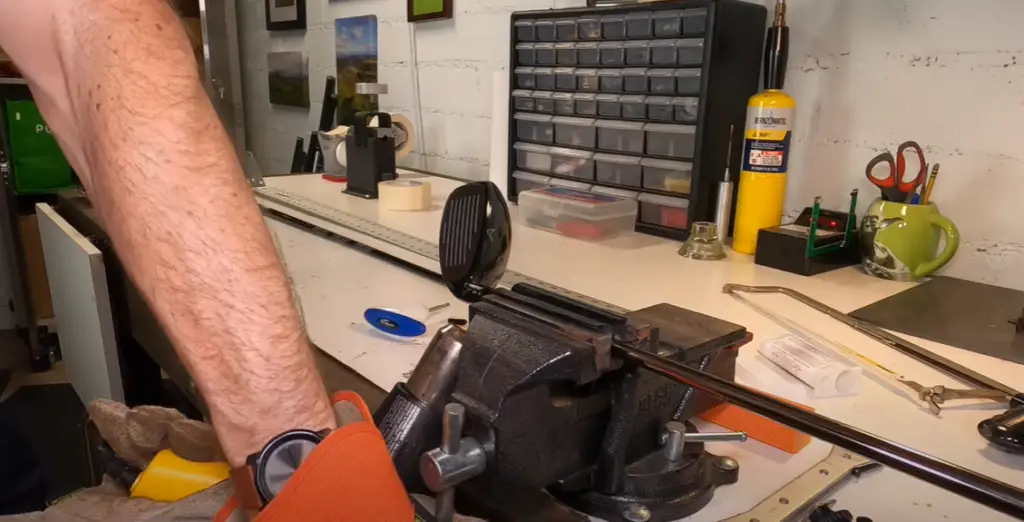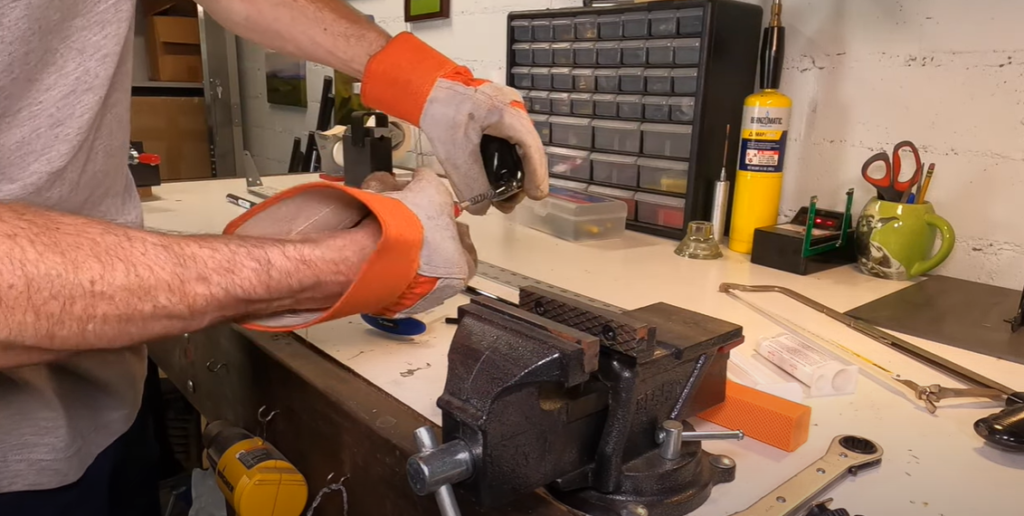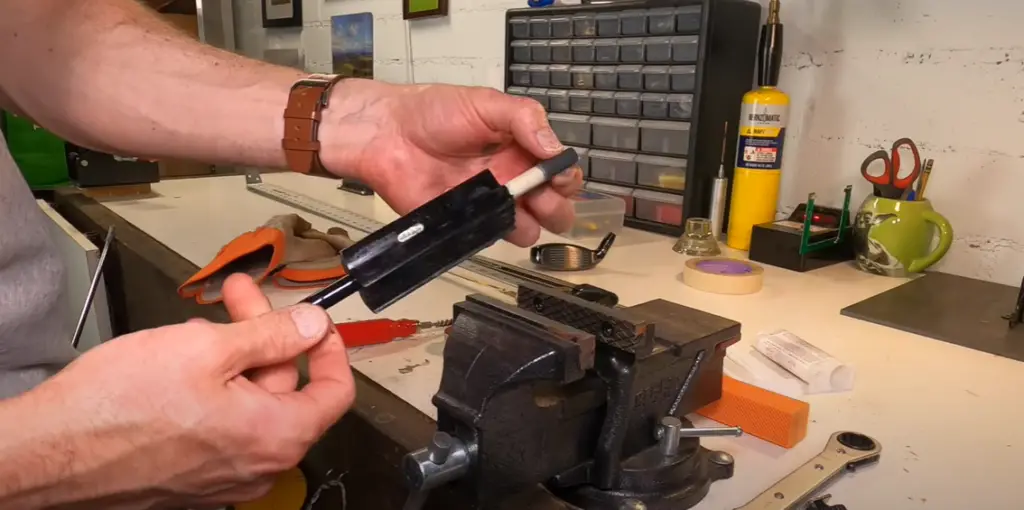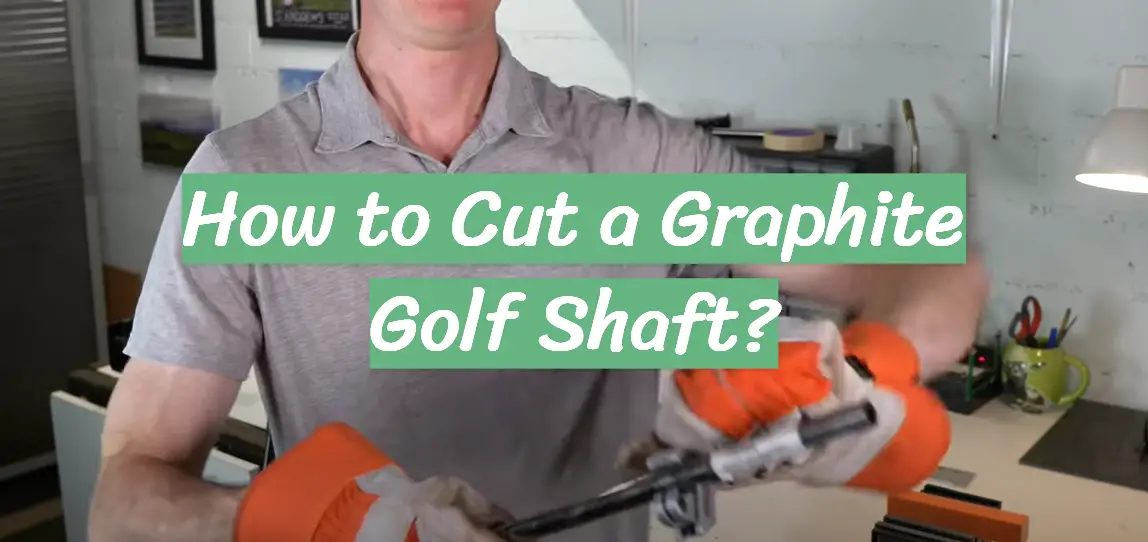When it comes to optimizing your golf game, the length of your golf shaft can significantly impact your performance on the green. Cutting a graphite golf shaft to an appropriate length can enhance control, improve swing speed, and ultimately, lower your golf scores. This guide aims to provide comprehensive steps on how to effectively cut a graphite golf shaft. Whether you are a golf enthusiast looking to customize your own clubs or simply interested in understanding the process, this guide will serve as a beneficial resource.
Table of Contents
Tools and Materials Needed
To successfully cut a graphite golf shaft, you will need to gather some specific tools and materials. First, a fine-toothed hacksaw is essential to ensure a clean cut. Next, a graphite shaft cutting blade is needed to protect the integrity of the graphite during the cutting process. You will also need a bench vise equipped with protective rubber vise clamps to securely hold the shaft while cutting. A measuring tape or ruler is necessary to accurately measure the length of the shaft. Lastly, for safety considerations, it is recommended to have a pair of safety glasses and work gloves to protect your eyes and hands during the process.[1]

Step-by-Step Guide
Marking the desired length
After you have gathered all the necessary tools and equipment, the next step is to mark the exact length you want to cut from the graphite golf shaft. Using your measuring tape or ruler, carefully measure out the desired length on the shaft. Once you have determined the appropriate length, use a non-permanent marker to draw a clear and visible marking on the shaft. This mark will serve as your cutting point. It’s advisable to double-check your measurements before proceeding to ensure accuracy. Remember, an error in this step can lead to an incorrectly sized shaft, impacting your golf game’s performance.
Securing the shaft
The next step in the process involves securing the graphite golf shaft to prevent it from moving during the cutting process. For this, you will need your bench vise and protective rubber vise clamps. Place the golf shaft in the bench vise such that the marked area is easily accessible. Be absolutely certain that the shaft is aligned correctly and that the mark is visible. Once in position, tighten the vise, ensuring the shaft is firmly held but not overly squeezed, which could cause damage. The protective rubber vise clamps will prevent any scratches or dents on the shaft during this step. This secure placement allows for a cleaner, more precise cut, and keeps your hands at a safe distance during the cutting process.
Cutting the shaft
With the graphite golf shaft securely held and the cutting point clearly marked, you are now ready to proceed with the cutting process. Wear your safety glasses and work gloves to protect yourself from any potential hazards during this step. Take the fine-toothed hacksaw equipped with a graphite shaft cutting blade in your hand and align it with the marked point on the shaft. Begin the cutting process with light, even strokes to establish a groove. Once the groove is established, you can gradually increase your pressure. Throughout the process, ensure you are applying steady pressure and maintaining smooth, regular strokes. This will help in preventing any splintering or cracking of the shaft. It’s important to note that graphite dust can be harmful if inhaled, so ensure your workspace is well ventilated or consider wearing a mask for this step. Continue sawing until you have completely cut through the shaft, always maintaining control over the hacksaw to ensure a clean, smooth cut.

Deburring the cut end
Once the cutting process is finished, the next crucial step is deburring the cut end of the graphite golf shaft. It’s not uncommon for the cut end to have rough edges or minor splinters from the sawing process. To ensure a smooth finish and prevent potential damage to the clubhead or your hands, you’ll need to deburr, or smooth out, the cut end. For this, you can use a file or sandpaper. If using a file, gently run it around the circumference of the cut end, making sure to remove any rough edges or splinters. If you’re using sandpaper, wrap it around the end and rotate the shaft while applying a slight pressure. Be cautious not to overdo it, as you don’t want to unintentionally alter the shaft’s diameter. After deburring, dust off any residual graphite particles. The end of your shaft should now be even, smooth, and ready for the next step of reattaching the clubhead.
Applying finishing touches
After the shaft has been properly cut and deburred, it’s time to apply the finishing touches. This primarily involves reattaching the clubhead and ensuring it fits securely. Fit the clubhead onto the shaft’s end, ensuring it aligns correctly. At this stage, epoxy resin is usually applied to secure the bond between the shaft and the clubhead. Make sure to use just enough glue to cover the hosel area, you don’t want any excess epoxy that could potentially drip down the shaft. Once the glue is applied, push the clubhead onto the shaft, twisting slightly as you push it down to ensure the glue spreads evenly. Leave the club to dry as per the epoxy resin’s instructions, typically 24 hours. Finally, regrip the club following manufacturer instructions for the grip you are using. Once the grip is installed and the clubhead is secure, your newly cut graphite golf shaft is ready for use. Remember to check all your fittings one last time before you hit the golf course. With the correct cutting and a precise fit, your performance on the green should see a marked improvement.[1]
Precautions and Tips
When cutting a graphite golf shaft, safety should always be a top priority. Always wear protective gear such as safety glasses and work gloves to prevent injury. Inhaling graphite dust can be harmful to your health, so perform this task in a well-ventilated area or consider wearing a mask.
Be careful not to squeeze the shaft too tightly when securing it in the vise, as this could cause it to crack. Use protective rubber vise clamps to avoid scratching or damaging the shaft.
After the cut, inspect the shaft thoroughly for any rough edges or splinters and deburr as needed. When reattaching the clubhead, ensure it aligns correctly with the shaft and secure it with the right amount of epoxy resin. Lastly, allow sufficient drying time after the clubhead has been attached and before you regrip the club.
Remember, practice makes perfect. Don’t be disheartened if you don’t get it right the first time. With patience and a bit of practice, you’ll be able to efficiently cut and fit your graphite golf shafts to your preference.[2]

Post-Cutting Considerations
Once you’ve successfully cut and fitted your graphite golf shaft, take note of the feel and performance of your modified club. The length of the shaft can significantly influence the swing weight, balance point, and overall performance of the club. If you find the club feels too light, or if it’s causing you to hit the ball off-target, you may want to consider adding a counterbalance weight in the grip end. Furthermore, it’s important to periodically check the clubhead’s attachment post-cut. Regular use may cause the epoxy bond to weaken over time, and you’ll need to reapply the epoxy if you notice any looseness. Post-cut maintenance also involves regular cleaning to keep the club in good shape. Use a soft cloth to wipe away any dirt or grit that may affect the club’s performance. Finally, if you’re unsure about any part of the cutting or fitting process, it’s always better to consult with a professional club fitter or repair specialist to avoid any costly mistakes and to ensure optimal performance on the golf course.[2]
Will cutting a golf shaft make it stiffer?
Contrary to what some may believe, shortening a golf shaft does not actually make it stiffer. The flex of a golf shaft is determined by its inherent design and materials, which remain unchanged even when the shaft’s length is altered. However, shortening the shaft can make it feel stiffer, as it reduces the length of the lever being swung and can potentially lower the amount of head swing. This can lead to an impression of increased stiffness. It’s also worth noting that cutting a shaft could affect the balance point, swing weight, and overall performance of the club. As such, any modifications should be carried out thoughtfully and with an understanding of the potential impacts on the club’s overall performance.[2]

How to replace a golf club shaft at home?
Replacing a golf club shaft at home can be a cost-effective way to maintain your golfing gear. Here are the steps to do it:
- Remove the Old Shaft: Secure the club in a vise, protecting the clubhead with a towel or cloth. Apply heat using a heat gun to the hosel area to loosen the epoxy, and then twist off the clubhead gently. Clean the inside of the hosel to remove any residual epoxy.
- Prepare the New Shaft: Once the old shaft is removed, prep the new one by sanding the tip lightly. This helps the epoxy bond better. Remember to clean any dust off the shaft after sanding.
- Install the New Shaft: Apply epoxy to the inside of the hosel and the sanded part of the shaft, taking care to cover all surfaces. Once the epoxy is applied, insert the new shaft into the hosel, twisting as you go to ensure coverage.
- Cure the Epoxy: Leave the club to cure as per the epoxy manufacturer’s instructions, usually 24 hours. You should not use the club during this time to allow the epoxy to fully set.
- Re-grip the Club: Once the epoxy has cured, you can apply the new grip. Use double-sided golf grip tape and grip solvent on the inside of the new grip, slide it onto the shaft, and let it dry.
- Test the Club: After everything is set and dry, the club is ready to be tested. Swing the club a few times to ensure the grip feels comfortable and the clubhead is secure.
Remember to take safety precautions like wearing safety glasses and gloves, and work in a well-ventilated area to disperse any fumes from the epoxy. If the shaft doesn’t fit perfectly or you’re unsure about any of the steps, it’s best to consult with a professional.[2]
FAQ
What do you cut graphite shafts with?
To cut a graphite golf shaft, you’ll need a specialized tool called a tubing cutter, specifically designed for graphite shafts. A hacksaw or a standard tube cutter, which are common tools used for cutting metal shafts, are not recommended for graphite shafts as they can cause the shaft to fray or splinter. In the absence of a graphite tubing cutter, a fine-toothed coping saw can also be used, but extra care should be taken to ensure a smooth cut. Always remember to use a vise to securely hold the shaft in place while cutting and wear appropriate safety gear to prevent injury.

Can I cut my own golf shaft?
Yes, you can cut your own golf shaft, provided you have the correct tools and feel comfortable doing it. The process requires a precise measure, a graphite tubing cutter, a vise to hold the shaft securely, and a deburring tool to smooth any rough edges left after the cut. It’s highly recommended to take all safety precautions, including wearing safety glasses and gloves, to minimize potential injuries. Also, keep in mind that any changes to the length of your golf shaft will affect the dynamics of your swing, so it’s crucial to measure correctly before cutting. Errors in this process can alter your club’s performance or even render it unusable. Therefore, if you’re unsure about any of the steps or the potential outcomes, it’s best to consult with a professional club fitter or repair specialist.
How hard is it to cut graphite?
Cutting a graphite golf shaft is not inherently difficult, but it requires a steady hand, the right tools, and a good understanding of the process. It’s crucial to have a high-quality graphite tubing cutter to prevent fraying or splintering of the shaft. The cut needs to be clean and smooth, and any rough edges must be properly smoothed with a deburring tool afterward. Care must also be taken to measure accurately before making the cut, as an incorrect length can significantly impact the club’s performance. Therefore, while the task is not overly complicated, it does demand precision, attention to detail, and respect for safety procedures. Given the potential impact on your golf club’s performance, if you’re not entirely confident in your ability to make the cut correctly, you might consider opting for professional assistance.
Can you cut a golf shaft with a pipe cutter?
While a pipe cutter might seem like a suitable tool for cutting a golf shaft, especially for those new to the process, it’s important to note that it may not be the best choice, particularly when dealing with delicate graphite shafts. Pipe cutters, especially those designed for metal pipes, can potentially cause the graphite shaft to fray or splinter, leading to possible damage and negatively impacting its performance on the golf course.
Instead, it is highly recommended to use a specialized tool called a graphite tubing cutter specifically designed for cutting graphite golf shafts. This tool is expertly crafted to slice through the shaft cleanly and smoothly, ensuring that the structural integrity of the shaft remains intact. By utilizing a graphite tubing cutter, you can minimize the risk of any unintentional damage and maintain the optimal performance of your golf shaft.
However, it’s worth noting that if you happen to be working with a steel shaft, a pipe cutter or even a hacksaw can be viable options for cutting. Nonetheless, it is crucial to always exercise caution and take necessary safety precautions. Before cutting any shaft, ensure that you are wearing appropriate protective equipment and securely fasten the shaft in a vise to prevent any accidents.
By following these guidelines and utilizing the right tools for the job, you can confidently cut your golf shafts without compromising their performance and longevity.
How do you cut a golf shaft?
Cutting a golf shaft can be carried out using the following steps:
- Secure the Shaft: Place the golf shaft securely in a vise. Make sure to protect the shaft from the vise’s metal grips by padding it with a cloth or rubber.
- Measure and Mark: Determine the length at which you want the shaft cut and mark it using a permanent marker. It’s crucial to measure accurately because a wrong cut can affect your swing dynamics.
- Cut the Shaft: If the shaft is graphite, use a graphite tubing cutter to make the cut. Steel shafts can be cut using a pipe cutter or a hacksaw. Always ensure the cut is made at a right angle to the shaft.
- Smooth the Edges: After the cut, there might be rough edges left on the shaft. Use a deburring tool or sandpaper to smooth these out.
- Clean the Shaft: Make sure to clean off any graphite or metal dust from the shaft.
Remember, safety is paramount. Always wear safety glasses and gloves to prevent injuries from flying shards or dust. If you’re unsure about any of the steps, it’s recommended to seek professional assistance.

How thick can a pipe cutter cut?
The thickness a pipe cutter can handle largely depends on its design and size. Standard pipe cutters, often used by plumbers, are typically capable of cutting through pipes with a thickness of up to 2 inches. These cutters are equipped with sharp blades that efficiently slice through the pipe material, making them suitable for common plumbing applications.
On the other hand, when it comes to larger pipes with considerably greater diameters, such as those found in industrial settings, specialized industrial-grade cutters are employed. These heavy-duty cutters are designed to handle pipes measuring several inches thick, enabling efficient and precise cutting.
However, when it comes to golf shafts, which are typically much thinner than standard plumbing pipes, a different approach is required. Using a regular pipe cutter for golf shafts is not recommended due to the risk of damaging the integrity of the shaft, especially in the case of graphite shafts. Instead, specialized tools like graphite tubing cutters or fine-toothed saws are often used. These tools provide the necessary precision and control to cut through the delicate and thin golf shafts without compromising their structural integrity.
It is crucial to remember that while a pipe cutter can technically be used to cut through a golf shaft, it is not the recommended method. Opting for the appropriate specialized tool ensures the longevity and performance of the golf shaft, minimizing the risk of damage and preserving its quality over time.
Useful Video: HOW NOT TO CUT GRAPHITE GOLF SHAFTS / Wrong Tool for the Job
Conclusion
Cutting a graphite golf shaft is a meticulous task that requires careful attention, the right tools, and a thorough understanding of the process. Whether you’re shortening your club for a better fit or building one from scratch, it’s crucial to approach the task with precision.
To start, accurate measurements are key. Make sure to measure and mark the shaft precisely before making any cuts. Using a graphite tubing cutter designed specifically for this purpose will help ensure clean and precise cuts.
Next, it’s important to securely hold the shaft in place before making any cuts. This can be done using a vise or a shaft clamp to prevent any movement or slippage during the cutting process. By properly securing the shaft, you can maintain control and accuracy throughout.
After the cut is made, it’s essential to carefully smooth any rough edges left behind. Using sandpaper or a fine-grit file, gently smooth out any imperfections to ensure a clean and professional finish. This step not only improves the aesthetics but also prevents any potential injury caused by sharp edges.
While it is possible to perform this task on your own, it’s advisable to seek professional assistance if you feel unsure about any part of the process. Remember, safety should always be the top priority when dealing with sharp tools and small graphite particles that can be harmful. Don’t forget to wear your safety glasses and gloves to protect yourself, and ensure you’re working in a clean and well-ventilated environment.
Lastly, it’s important to be aware that altering your club’s length can significantly impact its playability. Even a small change in length can affect the swing weight and overall feel of the club. Therefore, when making any cuts, approach the task with caution and knowledge, understanding the potential implications on your game.
By following these detailed guidelines, you can approach cutting a graphite golf shaft with confidence and precision, ensuring optimal performance and a club that suits your needs.
References:
- https://pluggedingolf.com/how-to-cut-a-golf-shaft-golf-club-building-101/
- https://sporticmedia.com/how-to-cut-a-graphite-shaft/







Leave a Reply